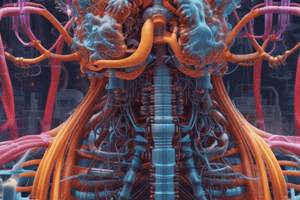Podcast
Questions and Answers
What is tidal volume and how does it change during exercise?
What is tidal volume and how does it change during exercise?
Tidal volume is the amount of air inhaled or exhaled in one breath, which increases significantly during exercise to meet higher oxygen demands.
Explain the significance of VO2 max in assessing an individual's fitness level.
Explain the significance of VO2 max in assessing an individual's fitness level.
VO2 max indicates the maximum rate of oxygen consumption during exercise and reflects cardiovascular and respiratory fitness.
How is minute ventilation calculated, and what is its normal range at rest?
How is minute ventilation calculated, and what is its normal range at rest?
Minute ventilation is calculated as VE = Tidal Volume (TV) × Respiratory Rate (RR) and has a normal range of approximately 6-10 L/min at rest.
What changes occur in minute ventilation during exercise and why are these changes important?
What changes occur in minute ventilation during exercise and why are these changes important?
What role do alveoli play in gas exchange in the lungs?
What role do alveoli play in gas exchange in the lungs?
How does the partial pressure gradient influence the movement of oxygen and carbon dioxide during gas exchange?
How does the partial pressure gradient influence the movement of oxygen and carbon dioxide during gas exchange?
Describe the process of oxygen diffusion from the alveoli to the bloodstream.
Describe the process of oxygen diffusion from the alveoli to the bloodstream.
Which muscles are primarily involved in respiration at rest versus during intense exercise?
Which muscles are primarily involved in respiration at rest versus during intense exercise?
Flashcards are hidden until you start studying
Study Notes
Ventilation Values for Exercise
Tidal Volume (TV)
- Definition: The amount of air inhaled or exhaled in one breath during normal breathing.
- Normal Range: Approximately 500 mL in adults at rest.
- During Exercise: Increases significantly to meet the higher oxygen demands of the body.
- Factors Affecting TV:
- Intensity of exercise: Higher intensity leads to greater tidal volume.
- Fitness level: Trained individuals may have a higher tidal volume compared to untrained ones.
VO2 Max
- Definition: Maximum rate of oxygen consumption measured during exercise.
- Significance: Indicator of cardiovascular and respiratory fitness, reflects the body’s ability to transport and utilize oxygen.
- Factors Influencing VO2 Max:
- Genetics: Plays a key role in determining baseline VO2 max.
- Training: Aerobic training can significantly enhance VO2 max.
- Body Composition: Lean body mass affects oxygen consumption.
- Measurement: Typically assessed through graded exercise tests (e.g., treadmill or cycle ergometer).
Minute Ventilation (VE)
- Definition: The total volume of air breathed in and out in one minute.
- Calculation: VE = Tidal Volume (TV) × Respiratory Rate (RR).
- Normal Range: Approximately 6-10 L/min at rest.
- Changes During Exercise:
- Increases with exercise intensity: Can rise to over 100 L/min in highly trained athletes during maximal effort.
- Primarily achieved through increases in both tidal volume and respiratory rate.
- Importance: Helps in meeting the increased metabolic demands for oxygen and the removal of carbon dioxide during physical activity.
Tidal Voume
- Amount of air inhaled or exhaled in one breath
- Approximately 500 mL in adults at rest
- Increases with exercise intensity based on oxygen demand
- Higher tidal volume in trained individuals
VO2 Max
- Maximum rate of oxygen consumption measured during exercise
- Indicator of cardiovascular and respiratory fitness
- Determined by genetics, training, and body composition
- Measured through graded exercise tests, such as treadmill or cycle ergometer
Minute Ventilation
- Total volume of air breathed in and out in one minute
- Calculated by multiplying tidal volume by respiratory rate
- Approximately 6-10 L/min at rest
- Increases with exercise intensity, primarily through increases in both tidal volume and respiratory rate
- Helps meet increased metabolic demands for oxygen and the removal of carbon dioxide during physical activity
Alveolar Gas Exchange
- Gas exchange happens in the lungs' alveoli, tiny air sacs surrounded by capillaries
- This maximizes surface area for oxygen to enter the blood and carbon dioxide to leave
Partial Pressure Gradients
- Partial pressure is the pressure of a specific gas in a mixture, and it drives gas exchange
- Oxygen has a higher partial pressure in the alveoli than in venous blood, causing it to diffuse into the blood
- Carbon dioxide has a higher partial pressure in venous blood than in alveoli, causing it to diffuse out of the blood
Oxygen Diffusion
- Oxygen moves from the alveoli (higher partial pressure) to the pulmonary capillaries (lower partial pressure) by simple diffusion
- This means it does not require energy
- Hemoglobin in red blood cells binds to oxygen, making it more efficient to transport throughout the body
Carbon Dioxide Removal
- Carbon dioxide, produced as a byproduct of cellular metabolism, is transported in the blood to the lungs
- It diffuses from blood (higher partial pressure) to the alveoli (lower partial pressure) to be exhaled
- Carbon dioxide is carried in three forms: dissolved in plasma, bound to hemoglobin, and as bicarbonate ions (HCO3-) in plasma
Pulmonary Ventilation
- Breathing rate and volume increase during exercise to meet greater oxygen demand and expel carbon dioxide.
- Increased contraction of the diaphragm and intercostal muscles powers larger tidal volumes and increased breaths per minute.
- Accessory muscles like the sternocleidomastoid, scalene, and pectoralis major become more active during heavier exercise.
Oxygen Uptake
- Oxygen consumption increases due to increased blood flow to working muscles and greater oxygen extraction from hemoglobin.
- Maximal oxygen uptake (VO2 max) is a measure of aerobic capacity and endurance.
- Fitness level, exercise duration, and intensity influence oxygen uptake.
Muscle Involvement
- The diaphragm and external intercostals are the primary respiratory muscles.
- As exercise intensity increases, accessory muscles like the sternocleidomastoid, scalene, and pectoralis major become more involved to increase thoracic cavity volume.
Impact of Exercise Intensity
- Ventilation rises faster than metabolism at a certain intensity, known as the ventilatory threshold.
- Respiratory muscle fatigue can occur at high intensities.
- Increased anaerobic metabolism leads to higher carbon dioxide production, further stimulating breathing.
Sternocleidomastoid
- An accessory respiratory muscle that elevates the sternum and clavicle, expanding thoracic cavity volume.
- Its role is more prominent during intense exercise when primary respiratory muscles are overwhelmed.
Studying That Suits You
Use AI to generate personalized quizzes and flashcards to suit your learning preferences.




